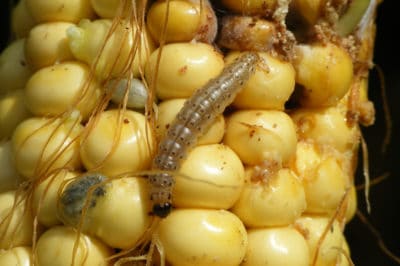Identifying the European Corn Borer
The first step to knowing you have a problem with the European Corn Borer is knowing how to identify it. There are other pests that gravitate toward corn, but if you are sure of what pest you have, you can target your treatment specifically for that particular pest.
The European Corn Borer spends the winter on your old corn stalks or other vegetable and weed debris. Because of this, you might not know you have an infestation until the larvae hatch.
Once they hatch, you will see them as small moths with the following characteristics:
- Female moths are a light yellow-brown color, with wavy lines across the wings.
- Male moths are smaller than females and are usually markedly darker than the females
- If they have the chance to mate, the eggs will look almost like the scales of fish in sets of around 20 eggs per laying.
Eradicating the European Corn Borer
Once you have identified that your corn has an infestation of the European Corn Borer, you need to take immediate steps to get rid of it. Otherwise, all the work and care you put into growing your corn will be for nothing.
Integrated Pest Management is one of the most successful ways to get rid of an infestation of the European Corn Borer, as well as a few other pests like the corn earworm that you might have. Ladybugs are of particular help, as they can consume over 50 eggs in a day.
Tip: If using beneficial insects does not take care of the whole problem, you can use a high-quality organic insecticide to finish off any remaining European Corn Borers.
Prevention of The European Corn Borer
As with moth garden pests, prevention of the European Corn Borer is genuinely the best way to handle this particular pest. Since the larvae winter in your old corn stalks, you should take care to remove them from the garden as you harvest each stalk. Then, either burn the refuse or finely chop the stems and plow them under the earth. This can be done in late fall or early spring.
You should also take great care to keep the area around your garden free of any weeds that the larvae may invade. Getting rid of the grubs is more than half the battle when it comes to eradication.
Whether you find success with one method or have to use a combination of techniques, getting rid of the European Corn Borer is incredibly important to the health of your corn crop. This is one pest you cannot afford to overlook.
